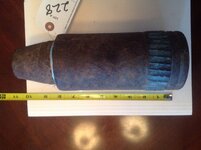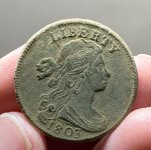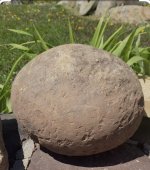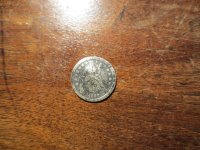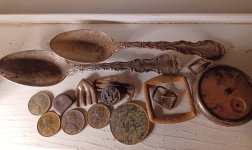You are using an out of date browser. It may not display this or other websites correctly.
You should upgrade or use an alternative browser.
You should upgrade or use an alternative browser.
Can anyone help identification on this ? Thank you
- Thread starter POORMANSMILITARIA
- Start date
Davers
Gold Member
- Jan 8, 2013
- 8,127
- 7,147
- Detector(s) used
- Whites Spc xlt & Tesoro Tejon- Now back ...Fisher 1266-X. TRX Pointer. New .Teknetics G2 + . New AT Pro .
- Primary Interest:
- All Treasure Hunting
Nope Sorry..
Good Luck..
Good Luck..
diggummup
Gold Member
- Jul 15, 2004
- 17,815
- 10,120
- Detector(s) used
- Whites M6
- Primary Interest:
- All Treasure Hunting
It's an artillery shell minus the fuze. Check this out- http://www.treasurenet.com/forums/what/23085-need-help-old-ww1-shell.html
TheCannonballGuy
Gold Member
- Feb 24, 2006
- 6,543
- 13,072
- Detector(s) used
- White's 6000, Nautilus DMC-1, Minelab
- Primary Interest:
- Relic Hunting
It is an artillery projectile, but from the World War One or Two era, definitely not from the civil war era. The slanted parallel ridges on the brass band are called rifling marks, and they mean your projectile has been fired. It is the class of artillery projectile called APCBC (Armor Piercing, Capped, Ballistic-Capped). Yours is missing its cap, which is a "missile nosecone shaped" metal cover attached to the projectile's nose to make it more aerodynamically efficient than the flat nose would be. Very similar ones are shown at the following website, although your exact version isn't. Scroll about halfway down the webpage to the APCBC-projectiles section.
An Introduction To Collecting Artillery Shells And Shell Casings - International Ammunition Association
Most of that type are Solid-Shot (non-explosive). But some had a fuze in the projectile's flat base. I need to see some closeup photos of your projectile's base to tell whether it is a Solid-Shot or an explosive shell.
An Introduction To Collecting Artillery Shells And Shell Casings - International Ammunition Association
Most of that type are Solid-Shot (non-explosive). But some had a fuze in the projectile's flat base. I need to see some closeup photos of your projectile's base to tell whether it is a Solid-Shot or an explosive shell.
Last edited:
Top Member Reactions
-
 2404
2404 -
 1139
1139 -
 1118
1118 -
 899
899 -
 826
826 -
 804
804 -
 763
763 -
 733
733 -
 629
629 -
 515
515 -
 480
480 -
 468
468 -
 467
467 -
 428
428 -
 402
402 -
 398
398 -
O
369
-
 365
365 -
 359
359 -
 352
352
Users who are viewing this thread
Total: 2 (members: 0, guests: 2)
